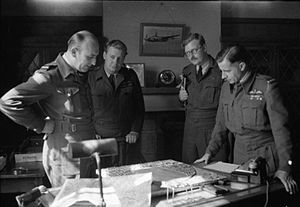David Atcherley
| David Atcherley | |
|---|---|

Air Vice Marshal Basil Embry (right) and his staff, c.1944. Atcherley is at left.
|
|
| Born |
12 January 1904 York, England |
| Died | 8 June 1952 (aged 48) Lost at sea (Mediterranean Sea) |
| Allegiance | United Kingdom |
| Service/branch |
British Army (1922–29) Royal Air Force (1929–52) |
| Years of service | 1922–52 |
| Rank | Air Vice Marshal |
| Service number | 05168 |
| Commands held |
No. 205 Group (1952) Central Fighter Establishment (1948–50) No. 47 Group (1946) No. 48 Group (1945–46) No. 323 Wing (1943) No. 325 Wing (1942–43) RAF Fairwood Common (1942) No. 57 Operational Training Unit (1941–42) No. 25 Squadron (1941) RAF Castletown (1940–41) No. 253 Squadron (1940) No. 85 Squadron (1938–40) |
| Battles/wars | Second World War |
| Awards |
Companion of the Order of the Bath Commander of the Order of the British Empire Distinguished Service Order Distinguished Flying Cross Mentioned in Despatches (3) Grand Officer of the Order of Leopold II (Belgium) Croix de guerre (Belgium) |
| Relations | Air Marshal Sir Richard Atcherley (brother) |
Air Vice Marshal David Francis William Atcherley, CB, CBE, DSO, DFC (12 January 1904 – 8 June 1952) was a senior Royal Air Force officer.
David Atcherley and his twin Richard were born on 12 January 1904, and were the sons of Major General Sir Llewellyn Atcherley, Chief Constable of the West Riding of Yorkshire, and his wife 'Nellie', Eleanor Frances (1871–1957), daughter of Richard Mickelthwait, of Ardsley House, in the valley of Deane near Barnsley. Their father was a grandson of David Francis Atcherley of Marton Hall, High Sheriff of Shropshire, Serjeant-at-law, Attorney-General of the County Palatine of Lancaster and County Durham. David Atcherley and his brother, first cousins of William Empson, attended Oundle School in Northamptonshire.
Atcherley entered Sandhurst Military Academy in 1922 after being rejected for the RAF due to medical grounds. In 1924 he was commissioned into the East Lancashire Regiment. His wish to fly succeeded when he was seconded to the RAF in March 1927. Proving to be an excellent pilot he was able to have his secondment converted into a permanent transfer on 1 October 1929.
At the start of the war he was Commanding Officer of No. 85 Squadron. He commanded No. 253 Squadron in May 1940 and more postings followed rapidly. His gained his first aerial successes as a night fighter when in command of No. 25 Squadron, which was equipped with Beaufighters, early in 1941.
...
Wikipedia
